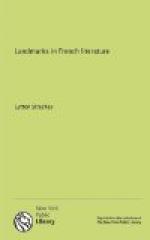It is this world of shifting lights, of queer, elusive, delightful absurdities, that La Fontaine has made the scene of the greater number of his stories. The stories themselves are for the most part exceedingly slight; what gives them immortality is the way they are told. Under the guise of an ingenuous, old-world manner, La Fontaine makes use of an immense range of technical powers. He was an absolute master of the resources of metre; and his rhythms, far looser and more varied than those of his contemporaries, are marvellously expressive, while yet they never depart from a secret and controlling sense of form. His vocabulary is very rich—stocked chiefly with old-fashioned words, racy, colloquial, smacking of the soil, and put together with the light elliptical constructions of the common people. Nicknames he is particularly fond of: the cat is Raminagrobis, or Grippeminaud, or Rodilard, or Maitre Mitis; the mice are ‘la gent trotte-menu’; the stomach is Messer Gaster; Jupiter is Jupin; La Fontaine himself is Gros-Jean. The charming tales, one feels, might almost have been told by some old country crony by the fire, while the wind was whistling in the chimney and the winter night drew on. The smile, the gesture, the singular naivete—one can watch it all. But only for a moment. One must be childish indeed (and, by an odd irony, this exquisitively sophisticated author falls into the hands of most of his readers when they are children) to believe, for more than a moment, that the ingenuousness of the Fables was anything but assumed. In fact, to do so would be to miss the real taste of the work. There is a kind of art, as every one knows, that conceals itself; but there is another—and this is less often recognized—that displays itself, that just shows, charmingly but unmistakably, how beautifully contrived it is. And La Fontaine’s art is of the latter sort. He is like one of those accomplished cooks in whose dishes, though the actual secret of their making remains a mystery, one can trace the ingredients which have gone to the concoction of the delicious whole. As one swallows the rare morsel, one can just perceive how, behind the scenes, the oil, the vinegar, the olive, the sprinkling of salt, the drop of lemon were successively added, and, at the critical moment, the simmering delicacy served up, done to a turn.
It is indeed by an infinity of small touches that La Fontaine produces his effects. And his effects are very various. With equal ease, apparently, he can be playful, tender, serious, preposterous, eloquent, meditative, and absurd. But one quality is always present in his work; whatever tune he may be playing, there is never a note too much. Alike in his shortest six-lined anecdote and his most elaborate pieces, in which detail follows detail and complex scenes are developed, there is no trace of the superfluous; every word has its purpose in the general scheme. This quality appears most clearly, perhaps, in the adroit swiftness of his conclusions. When once the careful preliminary foundation of the story has been laid, the crisis comes quick and pointed—often in a single line. Thus we are given a minute description of the friendship of the cat and the sparrow; all sorts of details are insisted on; we are told how, when the sparrow teased the cat—




